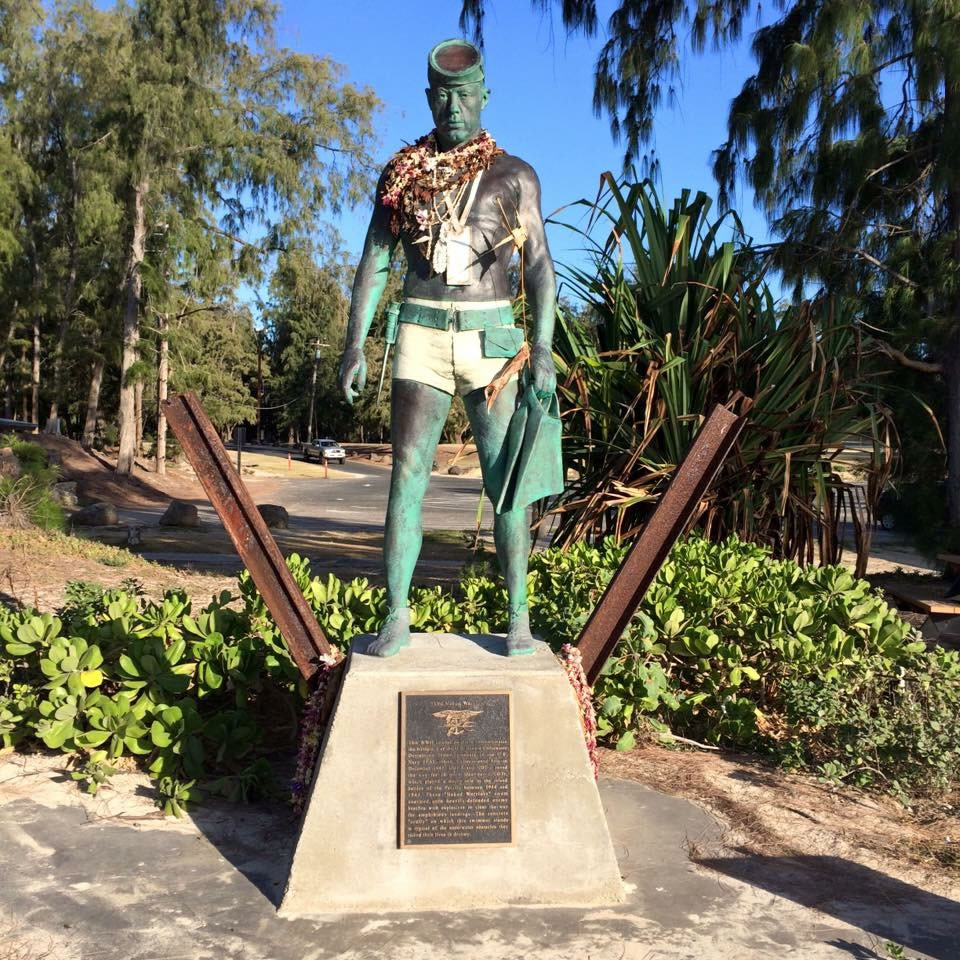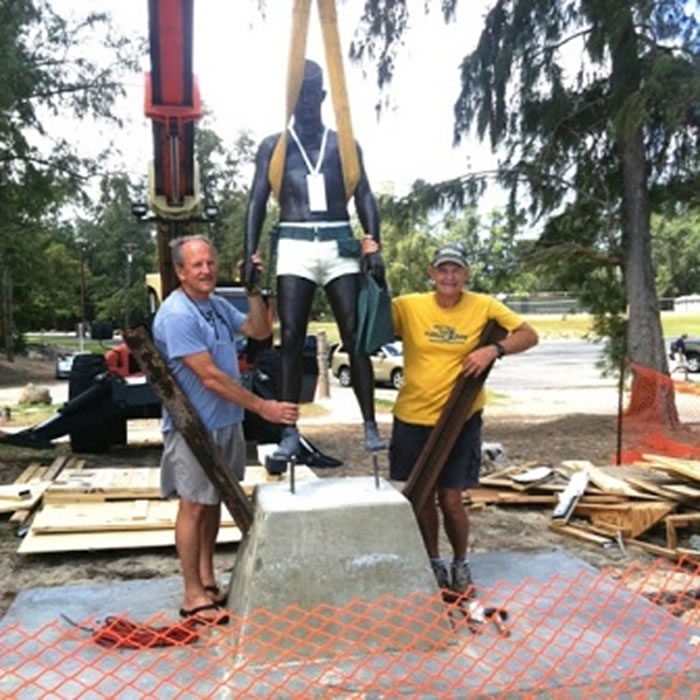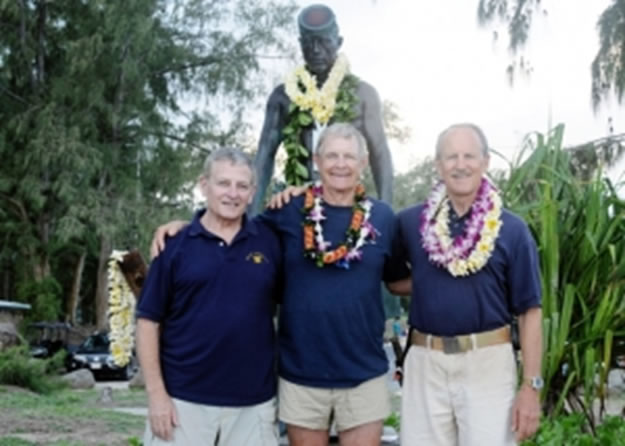Naked Warrior
Bellows AFS, Oahu, Hawaii
At a ceremony at Bellows Beach, Oahu, Hawaii on Veterans Day, November 11, 2014, a second Naked Warrior statue was dedicated to commemorate the establishment of the first Underwater Demolition Teams formed 71 years prior. These first UDTs were trained and deployed from the Amphibious Training Base (ATB) Waimanalo (Bellows Air Force Station) and, along with the other Pacific UDTs, were the true lineal forefathers of the U.S. Navy SEAL Teams.
The bronze plaque on the scully base reads as follows:
This WWII combat swimmer commemorates the birthplace of the U.S. Navy SEAL Teams. Commissioned here in December 1943, UDT-1 and UDT-2 paved the way for 28 more Maui-based UDTs, which played a major role in the island battles of the Pacific between 1944 and 1945. These “Naked Warriors” swam unarmed onto heavily-defended enemy beaches with explosives to clear the way for amphibious landings. The concrete “scully” on which this swimmer stands is typical of the underwater obstacles they risked their lives to destroy.
On November 22, 1943 at the start of the battle for Tarawa in the South Pacific, a submerged reef caused Marine amphibious landing craft to be grounded offshore, resulting in the loss of hundreds of Marines from enemy fire and drowning. After that experience, Admiral Richmond Kelly Turner, commander of the 5th Amphibious Force, directed that 30 officers and 150 enlisted men be assembled at Waimanalo, Hawaii to form the nucleus of a beach reconnaissance and demolition capability.
Gathered in early December 1943, this first group was formally designated UDT-1 and UDT-2, with planned strengths of 14 officers and 70 enlisted men each. They were termed “provisional” because their mission had not yet been clearly defined. Moreover, it is a little known fact that these first teams were joint teams–comprised of Navy, Army, and Marine Corps personnel.
Seabee CDR Edward Brewster and UDT-2 by LCDR John Koehler, USNR, who had been a veteran of Allied landings in Italy, led UDT-1. LCDR Koehler remained with UDT for the duration of the war. In 1949, President Harry S. Truman appointed him Assistant Secretary of the Navy.
With little more than a month to train, the men saw their first action on January 31, 1944 in the attacks on Kwajalein and Roy-Namur during Operation FLINTLOCK in the Marshall Islands. Following FLINTLOCK, the UDT men, under LCDR Koehler, returned to establish a Naval Combat Demolition Training and Experimental Base on a beach area adjoining ATB Kamaole on the island of Maui. This move was made, because ATB Waimanalo couldn’t handle the number of men anticipated to be trained, or the detonations of the large amounts of explosives that would be required for training.
After FLINTLOCK too, Army and Marine Corps men were returned to their parent services, and the Navy men that volunteered to remain were amalgamated into follow-on UDTs or became instructional staff, and led the way for establishment of 28 additional UDTs by the end of July 1945. “From this point forward, all UDTs were made up with the men from Fort Pierce–except UDT-14, UDT-16, and UDT-17, which were ‘fleet teams’ formed largely from volunteers throughout the Pacific Fleet.”
Between December 1944 and August 1945, UDT men saw action across the Pacific in every major amphibious landing and the occupation of Japan. It all began near the Bellows Naked Warrior statue, the only location on Oahu that commemorates the history and heritage of our nation’s first Underwater Demolition Teams. A small plaque was placed at the beach area in Maui some years ago to commemorate the activities of the UDTs there.
The Hawaii Naked Warrior Project was the initiative of former UDT and SEAL officers Brian Barbata and Ron Seiple (Hawaii residents), with support and assistance from Tom Hawkins in Virginia Beach and Rick Kaiser, Executive Director of the National Navy UDT-SEAL Museum. Brian and Ron dedicated themselves to all of the fundraising, acted as liaisons with Bellows AFS and the Pacific Air Force Command, and coordinated with the Navy SEAL Museum, which handled the funds donated for the project. It took about two years to raise the $50,000 needed for the project. Ron and Brian personally poured the foundation and scully, set the rails, and mounted the statue.
The statue is an exact duplicate of the one standing at the rear entrance to the National Navy UDT-SEAL Museum in Fort Pierce, FL. Rick Kaiser found that the molds still existed, and made arrangements to have the second statue cast by Deep in the Heart Foundry, the same artisans in Texas that did the original. The statue is bronze, and its coloration was accomplished with chemicals that will allow the statue to retain its current appearance for a very long time. The scully horns were from an old sugar cane railway on Oahu, obtained from the Hawaiian Railway Society.
A crowd of about 150 attended the dedication ceremony, which included welcome remarks by Brian Barbata and a brief history of the UDTs at Waimanalo by Tom Hawkins. They were followed by Ron Seiple, who explained WWII UDT capabilities and narrated a beach recon demonstration led by Navy SEAL Captain Travis Schweizer, Commodore, Naval Special Warfare Group THREE and his swim buddies. As the crowd watched, these SEALs cast from rubber boats just offshore, swam in with mock demolition haversacks, crossed the beach, and placed them on the scully. Commodore Schweizer, soaking wet in his traditional UDT trunks, then spoke about the relationship of the UDTs to today’s SEALs, and formally dedicated the statue. This was followed with a traditional blessing in Hawaiian from Reverend Kahu Kekuna.
In closing the ceremony, Brian Barbata thanked Major Dawn Standridge, the Commanding Officer at Bellows AFS, who greatly assisted in selecting the site and making the project a reality. Then, reading from the dedication program, he concluded with special thanks to those individuals and organizations that contributed goods, services, and donations to make the commemorative Naked Warrior a reality:
Dante Stephenson
Elizabeth Grossman
The Navy SEAL Museum
The Navy SEAL Foundation
Bellows AFS
Hardware Hawaii
Raytheon
Boeing
Intermarine
Pualani Landscaping
Island Ready Mix
Hawaiian Railway Society
Deep in the Heart Foundry
It should be noted that fundraising efforts for the Bellows statue were at a standstill until retired SEAL Dante Stephenson sent the Museum a check for $10,000. With that, and the $15,000 already raised from individuals, the NSF agreed to make up the rest, for a total project cost of about $40,000.
After the ceremony, everyone enjoyed keg beer (of course) and wine, as well as an exceptional array of pupus, provided by Kalapawai Market and Zia’s Caffe, two well-known local eating establishments.
Certainly, this Naked Warrior project would not have been possible without the assistance of the UDT-SEAL Museum and Rick Kaiser, especially. Anyone going to Hawaii should make an effort to visit this site, which is located on one of the most gorgeous beaches in the islands. The statue is located inside the security parameter of the Bellows Base, thus, a military ID is helpful to enter the gate. Bellows AFS also allows non-military entry to see the Naked Warrior with a temporary civilian pass arrangement.
Submitted by Brian Barbata


Barbata and Seiple preparing the Naked Warrior

Hawkins, Seiple, Barbata
